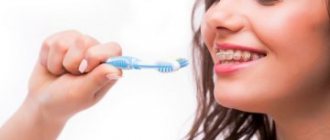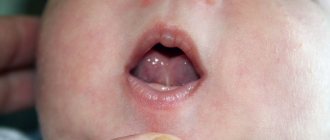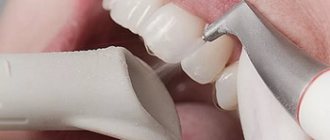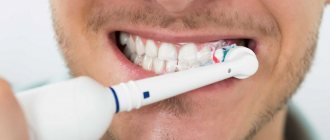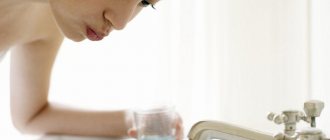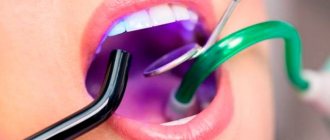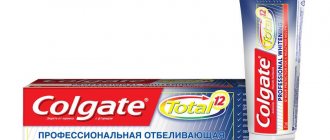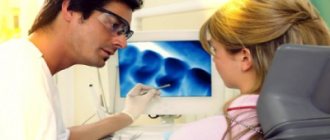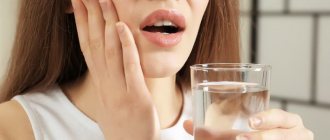When is it recommended to use?
Keep in mind! Not all children are able to clean their teeth efficiently using only toothpaste and a brush.
This is often due to a dislike of hygiene procedures, undeveloped coordination of movements, or a combination of these qualities.
Mouth rinse solutions are a kind of “final touch” and bring the result to perfection.
Until your baby gets used to rinsing his mouth and then spitting liquid into the sink, monitor his actions .
In addition, the baby mouthwash allows you to :
- reduce the likelihood of developing caries in baby teeth by 25%;
- accelerate processes after tooth loss;
- eliminate pathogenic fungi and bacteria;
- Form healthy habit every day .
Basics of care
Unfortunately, wearing braces causes some inconvenience when cleaning your teeth and gums. Their design is made in such a way that it blocks direct access to the surface of the enamel and the space between the teeth. This is fraught with the accumulation of a large amount of plaque and tartar, which in the future can cause caries and other dental problems.
To avoid this, experts advise using a number of devices, for example, irrigators, dental floss, brushes of different sizes, and rinses. In addition, the design features of braces systems do not allow the use of classic brushes for daily cleaning of teeth. Special mono-beam analogues and options with a protrusion will come to the rescue.
Professionals also argue that the use of ultrasonic devices to clean the oral cavity can damage the integrity of installed braces, especially plastic ones. This is why specially designed rinses come to the rescue.
At what age can you start using it?
You should know! Children's mouthwash can be used from 6 years of age.
Unlike adult hygiene products, they do not contain alcohol or sugar.
The flavoring and aroma additive is also - instead of sharp peppermint or menthol, sweet fruit, berry or candy flavors are most often used.
To form the right habit in your baby, buy two mouthwashes - one from the series for adults, the other for children.
together so your child can imitate you.
Tips for using baby mouthwash
To ensure mouth protection, it is necessary to teach the child how to use the solution correctly. For training, it is recommended to practice with regular water, this will save rinse liquid. It is necessary to convey that the product should not be swallowed. After success in training, it is recommended to repeat the rinsing process completely again. Initially, it is recommended to carry out the procedure for 30 seconds; if a person cannot withstand this time period, it can be reduced to 20 or 10 seconds.
If all the rules and the prescribed time for rinsing the mouth are followed, many advise rewarding the baby in the form of a symbolic “star” or sweets. We should not forget that after using the rinse, you must refrain from food and water for 30 to 60 minutes.
Kinds
To choose the right product, it is important to understand how and when it works best.
Stay up to date! There are four main types of rinse aids:
- Before cleaning . Designed to clearly demonstrate to the child which areas of the oral cavity he cleans the worst. Thanks to special reagents in its composition, it stains the areas of greatest accumulation of bacteria (plaque, cheeks, tongue, etc.). After this procedure, the baby will brush his teeth with more enthusiasm.
- After cleaning . A standard but effective means for high-quality cleaning of the oral cavity. It stops the reproduction and growth of pathogenic bacteria, eliminates bad breath and accelerates healing if mechanical damage to the mucous membrane has occurred.
- Against caries . Helps strengthen fragile tooth enamel, saturates it with fluoride and calcium, and inhibits the growth of cariogenic bacteria. Recommended for use in children prone to dental diseases or as an addition to the main treatment of caries.
- Plant based . A solution without dyes, sugar and aggressive chemical components. Freshen breath, suppress the growth of pathogenic microflora. Suitable for small children who may still swallow some liquid while brushing their teeth.
Mouthwashes - side effects
Mouth rinses contain only surfactants that cannot penetrate the oral mucosa and enter the bloodstream unless, of course, you swallow them. But nevertheless, mouth rinses are not as safe as they might seem, and the maximum negative effect develops with prolonged use.
What you need to pay attention to. Firstly, it is better to avoid products containing alcohol, because... with prolonged use, this leads to thinning and dryness of the oral mucosa. The second point is that if you have allergic manifestations on the mucous membrane of the oral cavity, then it is better to avoid rinses with parabens (for example, preservatives such as methylparaben or ethylparaben). Parabens cause oral allergies in approximately 4% of people.
If you periodically experience stomatitis (aphthous or herpetic), we recommend avoiding rinses with sodium lauryl sulfate. By itself, this component cannot cause stomatitis, but it leads to accelerated desquamation (squamation) of the epithelium of the oral mucosa, which makes the mucosa thinner and more vulnerable. It has been noticed that when using oral hygiene products with lauryl sulfate, outbreaks of stomatitis occur more often, and ulcerations of the mucous membrane take a longer time to heal.
Side effects of rinses with Chlorhexidine -
But most of the side effects are associated with long-term use of Chlorhexidine, which is included in almost every rinse for gum inflammation or bad breath. Reputable clinical studies (source) have revealed that within 7 days from the start of rinsing the mouth with chlorhexidine, global changes occur in the microflora of the mouth. Positive changes relate to the fact that chlorhexidine suppresses pathogenic bacteria that cause gum inflammation and bad breath.
But there are also negative aspects. A course of rinsing the mouth with chlorhexidine (reducing the number of some types of bacteria) simultaneously led to an increase in the number of other types of bacteria. Changing the ratio of different types of bacteria in the oral cavity has its consequences. For example, as a result of this, there was an increase in the content of lactic acid in the oral fluid (saliva), which led to a decrease in the buffer capacity of saliva and its ability to neutralize the acid produced by cariogenic bacteria in the oral cavity. Research clearly showed that chlorhexidine rinses led to a decrease in the pH of the oral fluid (i.e., its acidity increased).
And this is very important, because... a decrease in the pH of the oral fluid triggers the process of demineralization of tooth enamel, which significantly increases the risk of developing dental caries. Above we told you about the PRESIDENT Antibacterial rinse “Powerful protection against bacteria”, which contains 0.2% chlorhexidine - in combination with xylitol (xylitol). In this case, xylitol neutralizes the negative effects of chlorhexidine, because it has the property of reducing the acidity of oral fluid. This is also why we consider this mouthwash one of the best for treating gum inflammation.
Important: but that’s not all! Research has shown that chlorhexidine interferes with the ability of oral bacteria to convert nitrates (found in foods) into nitrites. This bacterial activity is called “nitrate-reducing” and is important for maintaining normal blood pressure. The fact is that nitrites help lower blood pressure, and accordingly, a decrease in the production of nitrites by oral bacteria leads to an increase in blood pressure.
This issue is important primarily for patients with chronic cardiovascular pathology. The above points are confirmed by the scientific study “The increase in plasma nitrite after a dietary nitrate load is markedly attenuated by an antibacterial mouthwash. Nitric Oxide" (2008), authors – Mirco Govoni, Emmelie Å. Jansson, Eddie Weitzberg, Jon O. Lundberg. If you wish, you can read this study using the link above using a browser translator.
How to choose?
Note! The choice of hygiene product should be based on the following parameters:
- Product composition – natural or chemical .
- Presence of oral diseases - preventive or therapeutic rinse.
- Flavor – mouthwashes can be fruit-flavored, unflavored, or hypoallergenic .
If you find it difficult to choose a mouthwash, consult your pediatric dentist.
Popular products for children
It is worth noting! Mouthwashes designed specifically for babies can be found in almost all well-known manufacturers of oral products.
Let's look at the most popular among consumers:
- "Listerine for children." Cleans up to 100% of the oral cavity, bringing hygiene to perfection. Strengthens tooth enamel, protects against childhood caries. Does not contain sugar or alcohol. It has a pleasant, berry taste.
- "ROCS" Universal rinses, suitable for both adults and children over 6 years old. Strengthens tooth enamel, relieves inflammation, acts as an antiseptic.
- " Dragon" . Has a wide range of flavors. Helps fight the signs of childhood caries, relieves inflammation, accelerates regeneration processes during tooth changes. It has a pleasant taste and attractive design.
- "Forest balm for children from 7 years old." Designed to strengthen enamel during the period of active growth of molars. Cleanses the oral cavity from bacteria where the brush fails. Does not contain alcohol.
- "SPLAT JUNIOR Magic foam." New among children's oral care products. The unique texture of fine bubble foam turns daily teeth brushing into an exciting game. With the help of a dispenser, the rinse turns into a cloud of sweet and aromatic foam, which allows a small dose of the product to fill the entire oral cavity. Pulls out food debris and plaque from the interdental space. Disinfects and freshens breath.
- " Levrana natural blueberry" . Rinse aid without sugar, alcohol, preservatives and harmful chemical components. The composition is absolutely natural and suitable for the prevention of early caries. It has a pleasant, grassy-blueberry taste.
- "New strawberry pearls" . Suitable for children from the age of three, as it is harmless even if accidentally swallowed. Disinfects the oral cavity during the phase of active tooth change. Recommended by orthodontists as an aid for dental care while wearing removable plates and braces.
How to apply it correctly?
For your information! It is necessary to accustom a child to rinsing the mouth without subsequent swallowing from an early age, optimally from two years of age.
Unfortunately, there is no decent industrial product for such babies, so you can use regular filtered water or chamomile decoction.
Explain to your baby that the liquid should roll around the mouth , passing between the teeth.
Demonstrate the movements by blowing air into your cheeks .
Starting from the age of 6, you can already trust the child to take care of the condition of the oral cavity independently , but still under close supervision from adults.
The sequence of actions should be as follows:
- Brushing teeth with paste. Let the child squeeze out the paste himself. Show that a pea-sized amount of product is enough for complete cleaning. Explain how to move the brush correctly to get rid of dirt. The optimal time for the procedure is 1.5 – 2 minutes. When finished, spit out the toothpaste and rinse your mouth with water.
- Using rinse aid . To determine the dosage, look at the back wall of the bottle - as a rule, all the necessary information is indicated there. In addition, most modern rinses are equipped with a special lid with a measuring machine. Do not allow your baby to swallow a mouthful of solution - this will increase the risk of swallowing. You need to rinse your mouth for 1-2 minutes, then spit the liquid into the sink.
Important! Starting from the age of 14, a teenager has the right to switch to adult mouthwashes, but in a smaller dosage (1/3 less).
Terms of use
There are certain rules for using this product. Dentists advise using the solution after each brushing of your teeth; you need to learn how to correctly distribute the amount of toothpaste and rinse.
If the first contains a high concentration of calcium and no fluoride, then it is recommended to purchase a fluoride-containing liquid. The average rinse time is 60 seconds; advice is written on the manufacturer's label.
Some people rinse their mouths with water after using the product, which is strictly not recommended. This is explained by the fact that water will wash away the active components of the rinse aid and the effect of its use will be minimal. Swallowing the liquid should be avoided as it is not intended to enter the stomach.
Accidental penetration of the product will not have a negative effect on the gastrointestinal tract.
There are a number of contraindications to the use of rinse liquid.
- Women during pregnancy or lactation are not recommended to use such liquids. There are no exact contraindications or negative effects on the body, but it is recommended to consult a dentist before purchasing.
- Most mouth rinses are suitable for use by children over 6 years of age; the recommended age is indicated by the manufacturer on the bottle. If the rinse aid contains alcohol, its use is permitted for people over 12 years of age.
- If clinical signs of an allergic reaction occur, you must stop using the rinse.
- The use of mouthwashes is not recommended for people undergoing treatment for alcoholism. Alcohol-containing rinses provoke breakdown and consumption of alcoholic beverages.
If there are contraindications, it is recommended to consult a dentist.

